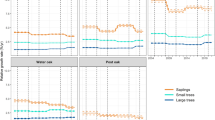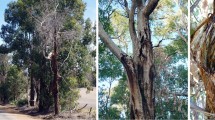Abstract
Laurel wilt disease (LWD) is a lethal fungal infection of woody plants in the Lauraceae, including redbay (Persea borbonia). We used forest inventory and analysis (FIA) data from 2003 to 2011 to estimate redbay populations and see if any decline could be observed since the introduction of LWD. Throughout its entire range, the population estimate of redbay was about 862.2 ± 89.8 million in 2003, increasing to 951.8 ± 87.1 million in 2011. However, population estimates from 2003 to 2011 displayed a significant negative curvature, suggesting that the population might start to decline. The population in Georgia significantly decreased from 241.1 ± 11.9 million stems in 2003 to 150.3 ± 7.9 million in 2011. Results at the range-wide scale should be taken with caution, since the FIA estimates are based on a 5-year moving average. However, we show that the FIA data can also be used on a smaller scale. Redbay densities decreased significantly in plots surveyed before and after the reported infection by an average of 89.6 live redbay stems/ha. Density in plots without reported LWD were not statistically different between survey years. We developed a logistic regression model to predict the probability of redbay mortality due to LWD. Number of years since LWD infection was the most significant variable, with every increase in 1 year resulting in a 153.7 % increase in odds of death. Diameter was also a significant predictor, with an increase of 1 cm DBH resulting in a 5.0 % increase in odds of death.





Similar content being viewed by others
References
Bates CA, Fraedrich SW, Harrington TC, Cameron RS, Menard RD, Best GS (2013) First report of laurel wilt, caused by Raffaelea lauricola, on Sassafras (Sassafras albidum) in Alabama. Plant Dis 97:688
Bechtold WA, Scott CT (2005) The forest inventory and analysis plot design. In: Bechtold WA, Patterson PL (eds) The enhanced Forest Inventory and Analysis program—National sampling design and estimation procedures. U.S. Department of Agriculture Forest Service, Southern Research Station. Gen Tech Rep SRS-80 Asheville, NC
Brar GS, Capinera JL, Kendra PE, McLean S, Peña JE (2013) Life cycle, development, and culture of Xyleborus glabratus (Coleoptera: curculionidae: scolytinae). Fla Entomol 96:1158–1167
Brendemuehl RH (1990) Persea borbonia (L.) Spreng. Redbay. In: Burns RM, Honkala BH (eds) Silvics of North America. Agriculture handbook 654. USDA Forest Service, Washington, pp 503–506
Cameron RS, Bates C, Johnson J (2008) Distribution and spread of laurel wilt disease in Georgia: 2006-08 survey and field observations. Georgia Forestry Commission, Georgia
Cameron RS, Bates C, Johnson J (2010) Evaluation of laurel wilt disease in Georgia: progression in redbay and sassafras 2008–2010. Georgia Forestry Commission, Georgia
Carrillo D, Crane JH, Peña JE (2013) Potential of contact insecticides to control Xyleborus glabratus (Coleoptera: curculionidae), a vector of laurel wilt disease in avocados. J Econ Entomol 106:2286–2295
Coder KD (2007) Taxonomy and identification: redbay (Persea borbonia). Univ Ga Warn Sch For Nat Resour Outreach Publ SFNR07-2 10p
Evans JP, Scheffers BR, Hess M (2013) Effects of laurel wilt invasion on redbay populations in a maritime forest community. Biol Invasions 15, Online First 8p
Fellows I (2012) Deducer: a data analysis GUI for R. J Stat Soft 49(8):1–15. http://www.jstatsoft.org/v49/i08/
Fraedrich SW (2008) California laurel is susceptible to laurel wilt caused by Raffaelea lauricola. Plant Dis 92:1469
Fraedrich SW, Harrington TC, Rabaglia RJ, Ulyshen MD, Mayfield AE III, Hanula JL, Eickwort JM, Miller DR (2008) A fungal symbiont of the redbay ambrosia beetle causes a lethal wilt in redbay and other Lauraceae in the southeastern United States. Plant Dis 92:215–224
Gillespie AJ (1999) Rationale for a national annual forest inventory program. J For 97:16–20
Goldberg N, Heine J (2009) A comparison of arborescent vegetation pre-(1983) and post-(2008) outbreak of the invasive species the Asian ambrosia beetle Xyleborus glabratus in a Florida maritime hammock. Plant Ecol Divers 2:77–83
Gramling JM (2010) Potential effects of laurel wilt on the flora of North America. Southeast Nat 9:827–836
Hanula JL, Mayfield AE, Fraedrich SW, Rabaglia RJ (2008) Biology and host associations of redbay ambrosia beetle (Coleoptera: curculionidae: scolytinae), exotic vector of laurel wilt killing redbay trees in the southeastern US. J Econ Entomol 101:1276–1286
Harrington TC, Fraedrich SW, Aghayeva DN (2008) Raffaelea lauricola, a new ambrosia beetle symbiont and pathogen on the Lauraceae. Mycotaxon 104:399–404
Harrington TC, Aghayeva DN, Fraedrich SW (2010) New combinations in Raffaelea, Ambrosiella, and Hyalorhinocladiella, and four new species from the redbay ambrosia beetle, Xyleborus glabratus. Mycotaxon 111:337–361
Hughes MA, Smith JA (2014) Vegetative propagation of putatively laurel wilt-resistant redbay (Persea borbonia). Native Plants 13:42–50
Hughes MA, Shin K, Eickwort J, Smith JA (2012) First report of laurel wilt disease caused by Raffaelea lauricola on silk bay in Florida. Plant Dis 96:910–911
Kendra PE, Montgomery WS, Niogret J, Epsky ND (2013) An uncertain future for American Lauraceae: a lethal threat from redbay ambrosia beetle and laurel wilt disease (a review). Am J Plant Sci 4:727–738
Koch FH, Smith WD (2008) Spatio-temporal analysis of Xyleborus glabratus (Coleoptera: circulionidae: scolytinae) invasion in eastern US forests. Environ Entomol 37:442–452
Lele SR, Keim JL, Solymos P (2013) ResourceSelection: resource selection (probability) functions for use-availability data. R package version 0.2–3. http://CRAN.R-project.org/package=ResourceSelection
Maner ML, Hanula JL, Horn S (2014) Population trends of the redbay ambrosia beetle (Coleoptera: curculionidae: scolytinae): does utilization of small diameter redbay trees allow populations to persist? Fla Entomol 97:208–216
Mayfield AE III, Brownie C (2013) The redbay ambrosia beetle (Coleoptera: curculionidae: scolytinae) uses stem silhouette diameter as a visual host-finding cue. Environ Entomol 42:743–750
Mayfield AE III, Barnard EL, Smith JA, Bernick SC, Eickwort JM, Dreaden TJ (2008) Effect of propiconazole on laurel wilt disease development in redbay trees and on the pathogen in vitro. Arboric Urban For 34:317–324
O’Connell BM, LaPoint EB, Turner JA, Ridley TR, Boyer D, Wilson AM, Waddell KL, Conkling BL (2013) The Forest Inventory and Analysis Database: database description and user manual version 5.1.5 for Phase 2. USDA Forest Service. http://www.fia.fs.fed.us/
Peña JE, Carrillo D, Duncan RE, Capinera JL, Brar G, McLean S, Arpaia ML, Focht E, Smith JA, Hughes M (2012) Susceptibility of Persea spp. and other Lauraceae to attack by redbay ambrosia beetle, Xyleborus glabratus (Coleoptera: curculionidae: scolytinae). Fla Entomol 95:783–787
Ploetz RC, Pérez-Martínez JM, Evans EA, Inch SA (2011) Toward fungicidal management of laurel wilt of avocado. Plant Dis 95:977–982
R Core Team (2013) R: a language and environment for statistical computing. R Foundation for Statistical Computing, Vienna, Austria. http://www.R-project.org/. Accessed 4 Nov 2013
Rabaglia RJ, Dole SA, Cognato AI (2006) Review of American Xyleborina (Coleoptera: curculionidae: scolytinae) occurring north of Mexico, with an illustrated key. Ann Entomol Soc Am 99:1034–1056
Reams GA, Smith WD, Hansen MH, Bechtold WA, Roesch FA, Moisen GG(2005) The forest inventory and analysis sampling frame. In: Bechtold WA, Patterson PL (Eds) The enhanced Forest Inventory and Analysis program—National sampling design and estimation procedures. U.S. Department of Agriculture Forest Service, Southern Research Station. Gen Tech Rep SRS-80 Asheville, NC
Riggins JJ, Hughes M, Smith JA, Mayfield AE III, Layton B, Balbalian C, Campbell R (2010) First occurrence of laurel wilt disease caused by Raffaelea lauricola on redbay trees in Mississippi. Plant Dis 94:634
Schenker N, Gentleman JF (2001) On judging the significance of differences by examining the overlap between confidence intervals. Am Stat 55:182–186
Scott CT, Bechtold WA, Reams GA, Smith WD, Westfall JA, Hansen MH, Moisen GG (2005) Sample-based estimators used by the Forest Inventory and Analysis national information management system. In: Bechtold WA, Patterson PL (eds) The enhanced Forest Inventory and Analysis program—National sampling design and estimation procedures. U.S. Department of Agriculture Forest Service, Southern Research Station. Gen Tech Rep SRS-80 Asheville, NC
Shields J, Jose S, Freeman J, Bunyan M, Celis G, Hagan D, Morgan M, Pieterson EC, Zak J (2011) Short-term impacts of laurel wilt on redbay (Persea borbonia [L.] Spreng.) in a mixed evergreen-deciduous forest in northern Florida. J For 109:82–88
Smith WB (2002) Forest Inventory and Analysis: a national inventory and monitoring program. Environ Pollut 116:S233–S242
Spiegel KS, Leege LM (2013) Impacts of laurel wilt disease on redbay (Persea borbonia (L.) Spreng.) population structure and forest communities in the coastal plain of Georgia, USA. Biol Invasions 15:2467–2487
USDA, United States Department of Agriculture, Forest Service, Forest Health Protection, Southern Region (2013) Distribution of counties with laurel wilt disease by year of initial detection. http://www.fs.fed.us/r8/foresthealth/laurelwilt/dist_map.shtml
VanDerWal J, Falconi L, Januchowski S, Shoo L, Storlie C (2012) SDMTools: species distribution modelling tools: tools for processing data associated with species distribution modelling exercises. R package version 1.1–13. http://CRAN.R-project.org/package=SDMTools
Westfall JA, Pugh SA, Coulston JW (2013) Conducting tests for statistically significant differences using forest inventory data. U.S. Department of Agriculture Forest Service, Northern Research Station. Research Paper NRS-22. Newton Square, PA
Wickham H (2009) ggplot2: elegant graphics for data analysis. Springer, New York
Acknowledgments
This study was funded by a Grant (SO-EM-B-12-05) from the US Forest Service Forest Health Monitoring Program. We thank Dale Starkey of US Forest Service and Laurie Reid of South Carolina Forestry Commission for their support, and US Forest Service Forest Inventory and Analysis Program for allowing us to access their database. We also thank the two anonymous reviewers who helped improve the manuscript.
Author information
Authors and Affiliations
Corresponding author
Rights and permissions
About this article
Cite this article
Shearman, T.M., Wang, G.G. & Bridges, W.C. Population dynamics of redbay (Persea borbonia) after laurel wilt disease: an assessment based on forest inventory and analysis data. Biol Invasions 17, 1371–1382 (2015). https://doi.org/10.1007/s10530-014-0799-6
Received:
Accepted:
Published:
Issue Date:
DOI: https://doi.org/10.1007/s10530-014-0799-6




